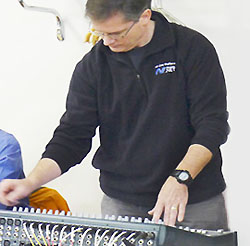Editor’s Note: Go here to read Part 1 of this series.
Experienced audio people have the ability to mix while keeping their eyes on the stage and the crowd. They know that they need to continually watch their musicians for visual cues in order to catch any trouble early and to verify that the people on stage are able to connect with each other.
Just as important, you should be regularly watching the audience to make sure they are engaging with the music and message. The surest way to verify that the mix is full and engaging is to watch your audience and see if they are into it.
I regularly teach new audio people that if they don’t see at least a few heads bobbing or toes tapping in the audience, they need to listen critically to their mix for changes that need to be made.
Know Right Where To Find It!
So if you’re going to mix like a pro and keep your eyes scanning the stage and the audience, having your eyes locked on your mixer is not an option. You need to be comfortable enough on your mixer that you know where everything is so you can move quickly to any given input without searching for it.
I can’t tell you how often I see churches make the mistake of having a poor input channel layout, which frankly contributes to struggling with the mix. Inputs should be arranged in a way that makes sense to anyone who walks up to the console, and should be clearly labeled so there’s no guessing or hunting for inputs. It seems like such a simple concept, yet so many churches don’t practice it.
Create a Standard Channel Layout
There are two common ways to layout the inputs of the console. The first one is what is very typical on concert tour riders and is the old school way of laying out your console. It’s the method that I tend to prefer, and it’s the layout I’m very comfortable mixing with—meaning that regardless of what console I’m on, I can find channels pretty fast without having to search for them.
Starting with channel 1 and working across, this method looks like:
Drums
Bass
Rhythm (electric and acoustic guitars, pianos and keyboards)
Other Instruments
Lead Vocal
Background Vocals
Speaker/Preacher/Announcement
Effects
Playbacks (like CD, DVD, computer, etc)
Drum Mic Channel Layout
If you’re miking the drums, chances are that you’re taking up several channels on your mixer to control the sound of the kit. Having an order for the drum mic channels is also necessary for you to make quick, accurate adjustments without having to think too much about which fader controls which mic.
Here is a common order for average drum set ups based roughly on mic priority:
Kick | Snare | Tom1 | Tom2 | Tom3 | Overhead L | Overhead R
Alternate Channel Layout
Another accepted method for stages that stay set up the same week after week is to lay the console out in the order that you see things on stage. The idea behind this layout is that the inputs are left to right as your stage appears from left to right, so as the physical matches the visual.
This method can make a lot of sense for churches that leave their setup the same all of the time, though for most of us that just isn’t reality. As an example of this setup, if the stage from left to right included a singing bass guitarist, lead singer/acoustic, drums, singer and an electric, your inputs would look like:
Bass
Bass Vocal
Acoustic
Lead Vocal
Drums
Background Vocal
Electric
Everything In It’s Place!
Regardless of what method you choose, the key is to choose some kind of organization that will group your channels in a way that you can find them quickly and easily, without searching. A console that has mic assignments spread out all over the place is tough to operate without focusing on the console.
With a consistent and logical channel layout, you’ll be able to mix quickly while keeping your ears and eyes up and active.
Duke DeJong has more than 12 years of experience as a technical artist, trainer and collaborator for ministries. CCI Solutions is a leading source for AV and lighting equipment, also providing system design and contracting as well as acoustic consulting. Find out more here.






















